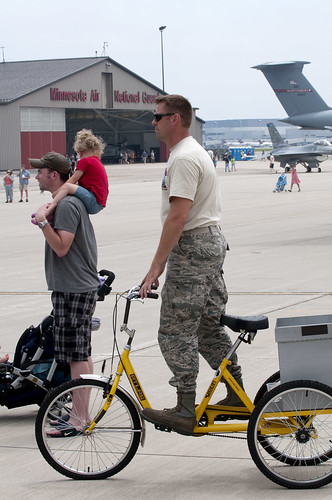 Photo courtesy of Minnesota Air National Guard
Photo courtesy of Minnesota Air National Guard
Earlier this month, I wrote a short column about the historical use of bicycling in the military.
While I was researching it, I chatted with Justin Haugens, who is the only person he knows who commutes by bike to the military base in Charlotte, North Carolina where he serves in the National Guard. He responded to my slew of questions well after the column was published, but I wanted to share them here.
What do you do in the military?
Structures Specialist in Civil Engineering with the North Carolina Air National Guard in Charlotte.
How often do you bike to work, how long is your trip, why did you start?
For drill weekends, I try to ride at least half the time but it depends on the location. The trip to drill includes a short bike ride to the nearest bus stop, two bus routes later I make the final 2 mile ride onto base. In total, it would be a 10 mile ride and it’s just safer to take the bus part of the way. I started in May 2010 after I had learned more about the bus system and became more comfortable in Charlotte.
What response do you get for showing up by bike?
The response is mixed, some think it’s great, some think it’s odd. Though it may come across as a joke, recently I arrived on base only to be told by another member in my unit out his window, “Go buy a car!” He was serious. But wait, I do own a car… Even some positive responses have a sense of puzzle in their tone. The military requires a helmet, lights, and in some cases high visibility clothing; as has been expressed by some in the global cycling community, these requirements actually hinder others from joining in for various reasons.
Do you get the sense that the military (or your part of it) is/could become friendly to bike transportation?
There are a lot of moving parts to this question. While in Gulfport, Mississippi for training, there were only a handful of regular cyclists on base. I was disappointed by this considering how flat and easy to ride the base was, small and compact. Though dedicated infrastructure was not constructed for cyclists, many vehicle operators were pleasant and cooperative with cyclists.
Do you think bases could become more friendly towards bike transportation?
Most definitely. The infrastructure on bases can be very similar to what you might encounter in a suburban neighborhood, sidewalks to nowhere–starting and stopping for unknown reasons, no sidewalks at all, and areas that appear to be catered solely to vehicle operators, i.e. narrow roads with zero shoulder. Generally speaking, you walk or drive, and adding bike lanes to the mix would greatly enhance base living. There needs to be support of it, though, even if it’s top-down. The military prides itself on physical readiness as we walk 20 yards from our office door to the vehicle in the parking lot. Cycling on base would offer another element to that readiness.
For those who I associated with daily, their commute was one-half mile. One-half mile. Yet I was the crazy one who wanted to ride my bike. I understand that they did not bring a bike with them, I just couldn’t imagine going somewhere like that for six months and not considering it.
There is plenty of room for improvement of on-base cycling infrastructure, education, and ridership. It still remains a choice to bike, but it could be viewed as a choice of leadership to push cycling as a better option too.
For more commentary about bicycling and the nation’s economic and cultural life, read the Bikenomics zine.